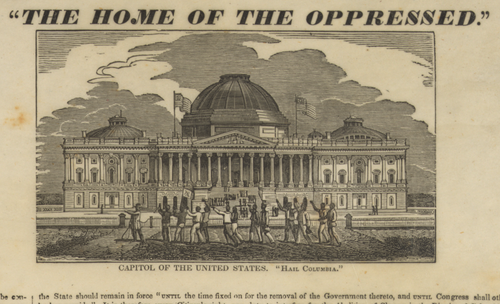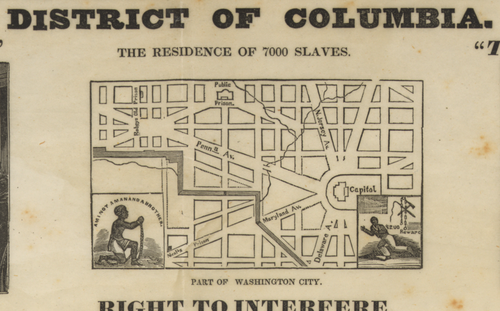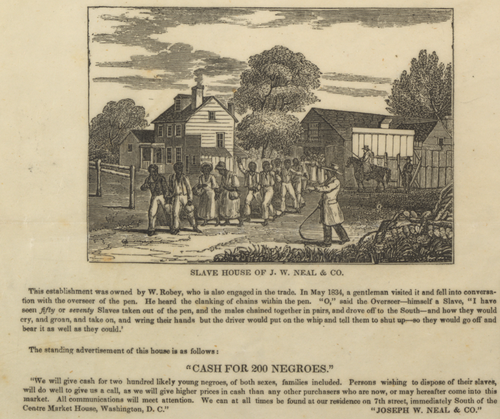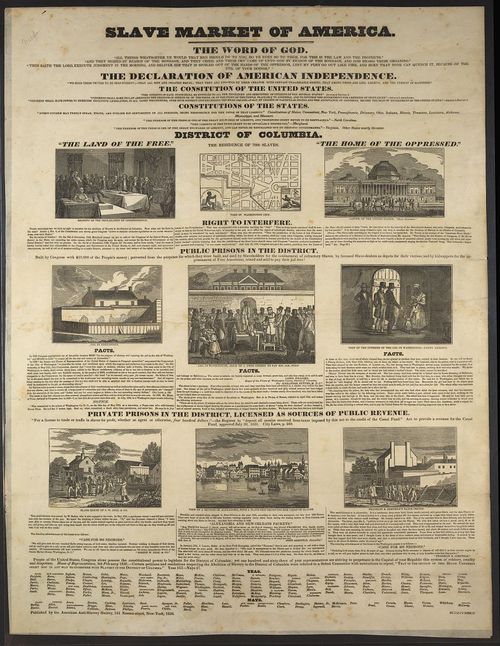JF Ptak Science Books Post 2490
 [Source: the Library of Congress, http://www.loc.gov/pictures/item/2008661294/]
[Source: the Library of Congress, http://www.loc.gov/pictures/item/2008661294/]
This is one of those graphics that tells an impossibly large story, too much for a short post like this, too much for a single book--it is a Grand Canyon of a story, a story about something so big that its gargantuan nature is self-evident.
I meant to include this in yesterday's post on a 200-word summation of slavery in an 1863 broadside by George Stroud, but it is better posted apart from anything.
This is a shocking document. It is big (64x48cm) and probably when it was pasted up on the side of a building or a fence or distributed with a newspaper that it must have stiffened its readers. The work is called Slave Market of America, and it is an indictment of the system of slavery, layering the institution of slavery on top of the great documents of U.S. history and portrays its practice on the background of the nation's capital.
 [Source: the Library of Congress, http://www.loc.gov/pictures/item/2008661294/]
[Source: the Library of Congress, http://www.loc.gov/pictures/item/2008661294/]
The inset map is one of the few from this period to identify the locations of slave establishments. Here they are identified as "prisons", which is what they were, but more accurately they were places to hold slaves during the slave sale process which would take place nearby. So the "prison" wasn't necessarily for law-breakers, but more so for holding the slaves as they were sold as property the ownership being transferred from seller to buyer.
And it was not only the slave owners and auctioneers making profit from this--there was also the support industries, like taverns and hotels and restaurants that provided the necessary infrastructure for such business to be conducted. The D.C. slave market was larger than the District--since it was situated between the two slave-holding states of Maryland and Virginia, it became a natural location for sales of slaves for the region.
I'm not going to say very much here and just let the broadside do the talking.
And the inset from the bottom of the broadside illustrating the Neal Slave House:
 [Source: the Library of Congress, http://www.loc.gov/pictures/item/2008661294/]
[Source: the Library of Congress, http://www.loc.gov/pictures/item/2008661294/]
These are all details from:
 [Source: the Library of Congress, http://www.loc.gov/pictures/item/2008661294/]
[Source: the Library of Congress, http://www.loc.gov/pictures/item/2008661294/]
"Summary: A broadside condemning the sale and keeping of slaves in the District of Columbia. The work was issued during the 1835-36 petition campaign, waged by moderate abolitionists led by Theodore Dwight Weld and buttressed by Quaker organizations, to have Congress abolish slavery in the capital. The text contains arguments for abolition and an accounting of atrocities of the system. At the top are two contrasting scenes: a view of the reading of the Declaration of Independence, captioned "The Land of the Free," with a scene of slaves being led past the capitol by an overseer, entitled "The Home of the Oppressed." Between them is a plan of Washington with insets of a suppliant slave (see "Am I Not a Man and a Brother?" no. 1837- ) and a fleeing slave with the legend "$200 Reward" and implements of slavery. On the next line are views of the jail in Alexandria, the jail in Washington with the "sale of a free citizen to pay his jail fees," and an interior of the Washington jail with imprisoned slave mother Fanny Jackson and her children. On the bottom level are an illustration of slaves in chains emerging from the slave house of J.W. Neal & Co. (left), a view of the Alexandria waterfront with a ship loading slaves (center), and a view of the slave establishment of Franklin & Armfield in Alexandria."--[Source: the Library of Congress, http://www.loc.gov/pictures/item/2008661294/]



Comments